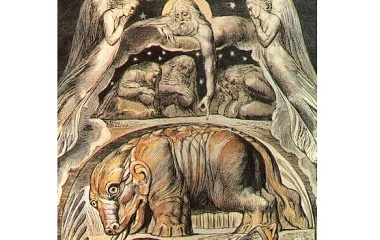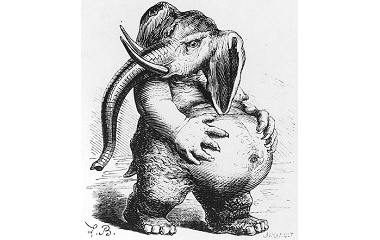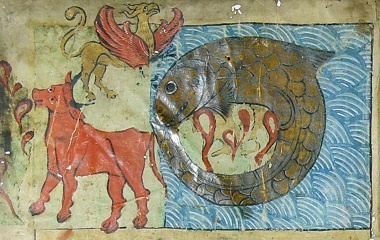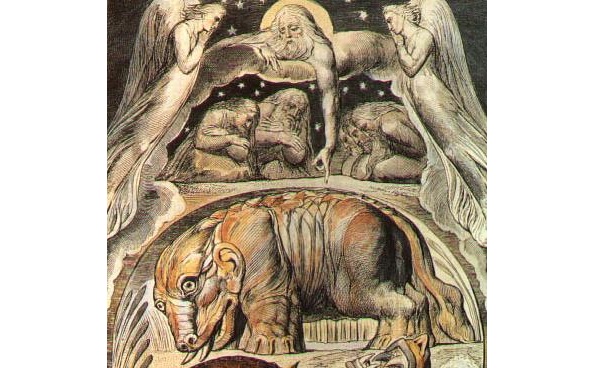What is a Behemoth
Despite humanity’s unquenchable curiosity surrounding the beast and its triad, little is known about their existence outside the book of Job. There have been speculations about what Behemoth was and where he could have come from.
Behemoth is said to be a primal land creature that was created by God when he crafted the world. Behemoth is a powerful land animal that cannot be defeated by anyone but God. Similarly, God created Leviathan – ruler of the sea, and Ziz – king of the sky. Shortly after Leviathan’s creation however, the creature was corrupted by Chaos.
Behemoth in the Bible
Most of what is known of the Behemoth comes to us from the book of Job, chapter 40. Job 40:16- reads as follows:
and which feeds on grass like an ox.
What strength it has in its loins,
What power in the muscles of its belly!
Its tail sways like a cedar;
the sinews of its thighs are close-knit.
Its bones are tubes of bronze,
its limbs like rods of iron.
It ranks first among the works of God,
yet its Maker can approach it with his sword.
The hills bring it their produce,
and all the wild animals play nearby.
Under the lotus plants it lies,
hidden among the reeds in the marsh.
The lotuses conceal it in their shadow;
the poplars by the stream surround it.
A raging river does not alarm it;
it is secure, though the Jordan should surge against its mouth.
Can anyone capture it by the eyes, or trap it and pierce its nose?”
Behemoth in Jewish Literature
Additionally, the Haggadah (a Jewish text that describes the order of the Passover Seder) tells us that the Behemoth is strongest during the summer solstice (usually around June 21st). During the summer solstice, the Behemoth lets out a mighty roar that makes all other animals of earth tremble with fear. The fear inspired by Behemoth’s roar makes animals less fierce. Without Behemoth’s roar, there would be nothing to stop animals from becoming terrifyingly violent and killing each other and humans without reason. In this way, Behemoth is also a protector of sorts that helps to keep weaker animals safe.
Physical Appearance
What we know of Behemoth tells us that he is a mighty creature whose strength cannot be comprehended by man. The Behemoth is said to be a masterpiece – a giant creature who cannot be conquered by anyone but God himself. Job 40 tells us that Behemoth is an incredibly powerful creature. The Behemoth is known to have a massive belly with powerful muscles that can be seen underneath the surface. Its bones are said to be dense as bronze and its limbs are strong as iron. Additionally, the Behemoth is said to be able to drink up a river with ease (KJV translation) and is able to stand against the might of the surging Jordan river without fear (NIV version).
Any beast capable of accomplishing these feats would have been very mighty indeed and feared by any who happened to come across it. However, despite the Behemoth’s terrifying appearance, the creature appears to be relatively peaceful. He enjoys laying underneath the shade of trees and reeds near rivers and is known to be a herbivore.
Many of the contextual clues surrounding the Behemoth have led scholars to believe that the mighty beast could have possibly been a hippopotamus or other similar creature. However, there are several problems with this theory that have discredited it.
One of the most important pieces of information that implies that the Behemoth is not an animal known to man is Job 40:17:
Many take this interpretation literally and suggest that the tail of the beast is either quite long (as cedar trees are known to grow to extreme heights) or bushy with hair similar to that of cedar limbs and leaves.
Others, however, argue that a literal interpretation is incorrect. It is well known that the Hebrews were very shy in their descriptions of the reproductive anatomy of both humans and animals. Instead, they used clever euphemisms that allowed them to avoid directly saying words they considered to be inappropriate. Because of this, many believe that the word ‘tail’ actually references the male anatomy of the Behemoth.
This explanation is further credited by the description of how the ‘tail’ moves. Though the NIV version of Job 40 uses the word ‘sways’, the original Hebrew word translates roughly to ‘move.’ This specific variation of ‘moves’ in the Hebrew language is also sometimes used to signify ‘to erect’, ‘to stand upright’, and ‘to stiffen.’
Many believe that Behemoth is a super-creature that has a strong resemblance to cattle. This is in part because of the name ‘Behemoth’ itself. In Hebrew, the word for cattle is ‘behemah’, which undeniably similar to ‘Behemoth.’ This leads many to believe that Behemoth must be some sort of ox-like creature with incredible strength and might.
Because of these implications, many believe that the Behemoth is a creature that is now extinct or has somehow gone undiscovered. Regardless of what Behemoth is, many doubt that it could be a creature that is known to us today.
Behemoth’s Motivation
Despite being incredibly large and incomprehensively powerful, the Behemoth does not seem to be a creature that wishes to wreck havoc on human-kind. Though this is counterintuitive when compared to the Leviathan (also an unconquerable primal creature) who devours humans and boils its enemies live by simply opening its mouth, this can possibly be explained by a creation myth.
It is said that God created Leviathan with a female partner and then created Behemoth. Shortly after creating Leviathan however, Chaos corrupted the creature. This forced God to kill Leviathan’s partner so he could not reproduce – together they would have been too powerful and devoured all other creatures of Earth.
Because Behemoth was not corrupted by Chaos, it is possible that this beast does not have evil intent. In fact, according to legend Behemoth and Leviathan are fated to battle against one another. This implies that Behemoth – who may be a protector of sorts – will battle against Leviathan to keep evil out of the world.
Another supporting factor for Behemoth’s gentle nature is the fact that he is a known herbivore. Unlike many monsters and creatures known to have malevolent intent, Behemoth does not crave the flesh of any being or animal. He also does not roam in search of trouble, but instead lays peacefully under the shade of trees and reeds.
Perhaps most importantly, Behemoth is known to let out a mighty roar during the summer solstice when his powers are at their peak. This roar is known to frighten all the animals into lessening their ferocity so that all the weak animals can live in peace.
Origin Theories
The tale of Behemoth, Leviathan, and Ziz has fascinated humanity since we were first made aware of their existence. The creature is known for its great power and might that is unconquerable to all but God himself. Though there is still no strong evidence to support any theory that is posed as a solution, the following have become the most popular and intriguing.
Hippopotamus
As hippopotamus were considered to be great and mighty creatures in the ancient world, it has often been wondered if Behemoth could have been a description of the river horse. The argument for Behemoth being a massive hippopotamus is usually supported by saying that Behemoth is known to have a large belly, similar to that of a hippo.
Hippopotamus’ are also known to enjoy basking in the shade of river plants and being able to withstand strong currents. There are, however, several problems with this theory.
The first issue lies in the description of Behemoth’s stomach. While certainly large like that of a hippopotamus, the Behemoth has visible muscles that line its stomach. A hippo’s stomach has no visible muscle.
Additionally, though hippopotamus’ are known to be impressive creatures, they were also hunted by men during the time that this passage is thought to have been written. The last lines of the poem, contradict any possibility of the hippopotamus being the infamous Behemoth. They read as follows:
These were the methods used by ancient Egyptians to bring down a hippopotamus. They would often aim to blind the hippo by aiming for its eye, or stab it in the nose to force the creature to breath through its mouth. When this was accomplished, they could then use a spear to deliver a fatal blow to the more vulnerable insides of the creature.
Hippos were also commonly sacrificed and eaten during festivals in ancient Egypt. Behemoth is an unconquerable creature and is not able to be preyed upon by any creature on Earth.
It is however, thought that the first notions that Behemoth could be a hippopotamus are linked to the pharaoh’s pride in being able to kill one of the mighty creatures. In ancient Egypt, this was thought to further evidence their status as an incarnated god.
Dinosaur
If Behemoth is not a hippopotamus, what then could he be? Many frustrated scholars turn back to the dawn of the dinosaurs to answer this question. There are several different species of dinosaurs that are brought into consideration. It is argued that since we do not know the date that dinosaurs went extinct, there could have been a few existing species during Job’s time.
Apatosaurus is often one of the candidates for a possible Behemoth that is thrown into the ring. The creature’s teeth are consistent with that of an herbivore, which helps to align the creature with Behemoth. The Apatosaurus is thought to have grown to lengths up to 75 ft and could have weighed as much as 22.0 long tons! However, it is believed that several Apatosaurus’ could have grown even larger than this.
Other types of sauropods were also mentioned for their large size and herbivore diet. Because of their bone structure, it is also thought that rigid muscles would have been visible on the stomachs of these creatures. Admittedly, the creatures would have inspired fear and awe into anyone who happened upon them.
The major flaw with this theory however, is found in the otherwise very detailed descriptions of Job 40. The animal is described with incredible detail, but there is no mention of the enormous neck that is characteristic of sauropods. Many also argue that the tail of the sauropods – though massive – didn’t resemble a cedar tree.
Ox
The majority of people who reject the two above theories usually gravitate towards the belief that the Behemoth is a type of super-ox that was superior to all other creatures. This is largely due to the word ‘Behemoth’ itself.
The word ‘Behemoth’ is thought to be a derivative of ‘behemah’ which is a Hebrew word for cattle. This close association would lead the majority of believers to think that Behemoth is a large variation of mammal that is somehow related to the cattle family.
This belief is also more commonly accepted because of the many extinct species that are still being discovered today. It is often claimed that this is why we have yet to discover the Behemoth – it became extinct long ago and is yet to be discovered by modern man.
Mud Fossil
The study of mud fossils are usually limited to trying to understand the history of the Earth by examining rocks and soil. It is quite common for scientists to find the fossils of fish and other sea creatures buried in rock and mud.
There are those however, who believe mud fossils have the potential to tell a much greater story. In fact, some would claim that the majority of land masses on Earth are actually made from the decaying remains of giants! Though this theory is often dismissed, its premise does coincide with the creation story passed down from the Norse in which Odin, Vili, and Ve create the Earth from the body of the giant Ymir.
Those who believe in this extreme mud fossil theory have claimed to have found the remains of Leviathan and Behemoth in the Sahara Desert (though the description of the second figure aligns with that of Ziz more closely than Behemoth).
Possible Accounts of Behemoth in Other Cultures
There are many related characters in ancient mythology that could have inspired Behemoth or serve as an alternative representation of Behemoth.
Audhumla
One possible relation is Audhumla who comes to us from Norse mythology. Audhumla is a giant cow who provided sustenance for the first of the frost giants and created the first gods (Buri and Bestla). The story of Behemoth tells us that this creature is known for the power in its loins. In the ancient world, this was often used to convey the fertility of certain creatures. This may be a reference to the power of life that is endowed in the creature, which could connect Audhumla to Behemoth.
The Sacred Bull
We also hear tales of the Sacred Bull that was commonly worshiped in the ancient world. One of the most familiar stories was that of Moses and his followers. When Moses went atop Mount Sinai, he left his followers at the base of the mountain and told them to wait. Because of the long time he spent on the mountain, his followers strayed away from God and started worshiping The Sacred Bull. Moses was angered by this, telling them that this ‘god’ they were pledging allegiance to was nothing compared to the great might of God and destroyed all their relics. Many believe The Sacred Bull could indeed be Behemoth. If The Sacred Bull is Behemoth, this could perhaps be seen as motivation for killing the otherwise peaceful creature alongside Leviathan in the end days.
The Bull of Heaven
The Epic of Gilgamesh also depicts a bull that could have been a reference to Behemoth. In this story, the Bull of Heaven is sent down to punish humans and destroy their crops because Inanna (sister of the goddess of the Underworld) had been upset by Gilgamesh. She begged Anu (god of the sky) to release the Bull of Heaven from his place in the sky so he could avenge her honor. Because of Inanna’s ties to the story, it is thought that the Bull of Heaven could actually be Gugalanna, the first husband of Ereshkigal (goddess of the Underworld and sister to Inanna). Anu agrees and lends the power of Gugalanna to Inanna. She unleashed The Bull of Heaven upon the kingdom of Gilgamesh, where he consumed the vegetation and drank up the rivers. Some versions of the story tell us that The Bull of Heaven was able to drink up a mile of river at a time and still thirst for more water – similar to what we hear in stories relating to Behemoth. Eventually, The Bull of Heaven is slain by Gilgamesh and his companion Enkidu, though it is said that the great bull was preserved in the sky as the constellation Taurus.
Apis
Egyptian mythology brings us the deity Apis – the bull god. As one of the oldest deities in Egypt, he is one of the most important gods the Egyptians had and was often given ritual sacrifice out of reverence and respect. Apis is a servant of Ptah – the god of creation. This leads many to believe that Apis may be none other than Behemoth as the tales have startling similarity. However, instead of considering Apis to be a lesser creature than Ptah, they considered him to be a manifestation of Ptah which is why he is given so much respect.
Gavaevodata
Iranian mythology also tells the tale of Gavaevodata – a uniquely created cow that was both male and female. Gavaevodata is considered to be one of the six primordial material creations and is credited with being the creator of all benevolent animal life. This can perhaps be likened to Behemoth in that Behemoth’s mighty roar is considered to be a merciful act that protects the weaker animals of the world.
Nandi
Hindu mythology brings us the legend of Nandi who may also be a reference to Behemoth. Nandi is the gate guardian of Kailasa and is also the steed of the god Shiva. It is said that when Nandi was born, his body was protected by armor made from diamonds. As diamonds are known for their incredible strength, it is possible that Nandi’s iron-like body and bronzen bones could have been a description of Behemoth.
Explanation of the Myth
There are many debates as to who or what Behemoth is – as well as if the creature exists at all. The most popular theories suggest that the creature was either an analogy created to demonstrate the might of God or a creature that has been extinct for centuries.
Many are convinced that the former is the most likely explanation. Because Behemoth is so prominent throughout the cultures that early Christians interacted with, it is thought that introducing Behemoth as one of God’s creations was meant to show the inferiority of the deity to the other cultures and religions. In fact, portraying Behemoth as a land monster ensured that the dignity associated with being a deity was stripped away from Behemoth entirely.
Others believe that Behemoth is a sort of mammal that has been extinct for hundreds or even thousands of years. The creature they expect to unearth is often compared to the early dinosaurs.
There are also those who believe Behemoth was a giant that was used to create the land that now comprises a large portion of Earth. This is a fairly uncommon belief, though followers of this idea claim to have found fossilized evidence that confirms their theory.
Regardless of how the legend of Behemoth came into existence, he can be recognized as an important creation figure in cultures around the world.











